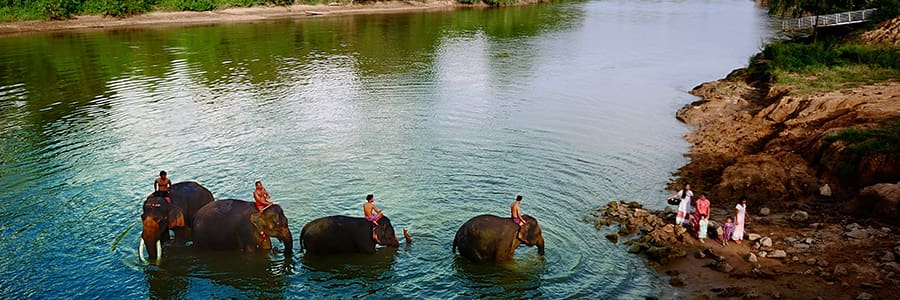
About The River Kwai
Kwai is pronounced with a soft “a,” as in “glad.” The word Kwai pronounced like “why” means “buffalo” in Thai.
Known mostly to Westerners as the setting for the movie “Bridge over the River Kwai,” the lovely and tranquil Kwai is in fact two rivers, the Kwai Yai and the Kwai Noi, the merge at Kanchanaburi, site of the actual bridge. From its source in the Tenasserim Hills, it flows for nearly 240 miles through Thailand, nurturing one of the most beautiful and culturally diverse countries in Southeast Asia.
Rich with spectacular scenery, wildlife, and birds, the Kwai is a naturalist’s dream. Cruising through the jungle, past dramatic gorges and cascading waterfalls, under trailing orchids and chattering birds, you’ll feel like one of the great explorers of old. You’ll even venture into the jungle to meet tribes-people who will consider you the strange and exotic creature!
Limited cruise lines offer Kwai river cruises as part of a Thailand tour, and all charter the local river cruisers, that were built in the romantic colonial style but featuring modern comforts and amenities. The River Kwai is definitely the road less traveled and a very unique addition to any Southeast Asia journey.
River Kwai Stats
Length: 236 miles
Depth: Various
Source: Tenasserim Hills, Thailand
Mouth: Mae Klong River into the Gulf of Thailand
Locks: 0
Countries: Thailand
Learn More About the River Kwai
The Kwai River, also known as the Khwae Noi River or Khwae Yai River, is a significant waterway in Southeast Asia, renowned for its historical significance, natural beauty, and cultural importance. Stretching across Thailand and Myanmar, this river has captured the imagination of people around the world due to its association with the infamous Death Railway, as well as its stunning landscapes and rich biodiversity.
Geography and Origin
The Kwai River originates in the mountainous region of the Tenasserim Hills in Myanmar, near the border with Thailand. It flows in a generally southward direction, eventually joining the Mae Klong River in western Thailand. The river’s name is somewhat contentious, as there are two branches, the Khwae Noi (Small Kwai) and the Khwae Yai (Big Kwai), both contributing to the river’s overall flow. Despite this, the name “Kwai River” is commonly used to refer to the entire watercourse.
Historical Significance
The Kwai River is most famously associated with the construction of the Burma Railway during World War II. The Japanese Imperial Army forced prisoners of war, as well as Southeast Asian laborers, to build this railway to support their military operations. The construction of the railway was brutal and grueling, with harsh working conditions and inadequate supplies. Thousands of laborers died during its construction, leading to the nickname “Death Railway.” The most iconic structure along the Death Railway is the Bridge on the River Kwai, made famous by the novel written by Pierre Boulle and the subsequent film adaptation directed by David Lean. This bridge has become a symbol of the suffering and sacrifice endured during its construction. Visitors can still see the remnants of the bridge, which stands as a somber reminder of the past.
Natural Beauty
Beyond its tragic history, the Kwai River is renowned for its natural beauty. As it winds its way through lush tropical forests and rugged terrain, it offers breathtaking views at every turn. The surrounding landscape is characterized by limestone cliffs, dense jungles, and picturesque waterfalls, making it a popular destination for eco-tourism and adventure seekers. One of the most visited attractions along the river is the Erawan National Park, which is famous for its seven-tiered waterfall. The cascading emerald waters of Erawan Falls attract visitors who come to swim in the pools and enjoy the pristine environment. Wildlife enthusiasts can also spot various species of birds, reptiles, and mammals in the region.
Cultural Significance
The Kwai River is not only a place of historical and natural significance but also holds cultural importance for the communities that live along its banks. The river has been a vital source of water, transportation, and sustenance for the people in the region for centuries. Traditional villages dot the riverbanks, and the local culture is deeply intertwined with the life of the river. Visitors to the area have the opportunity to immerse themselves in the local culture, enjoying traditional Thai and Mon cuisine, attending cultural festivals, and observing the daily lives of the people who call the Kwai River Valley home.
